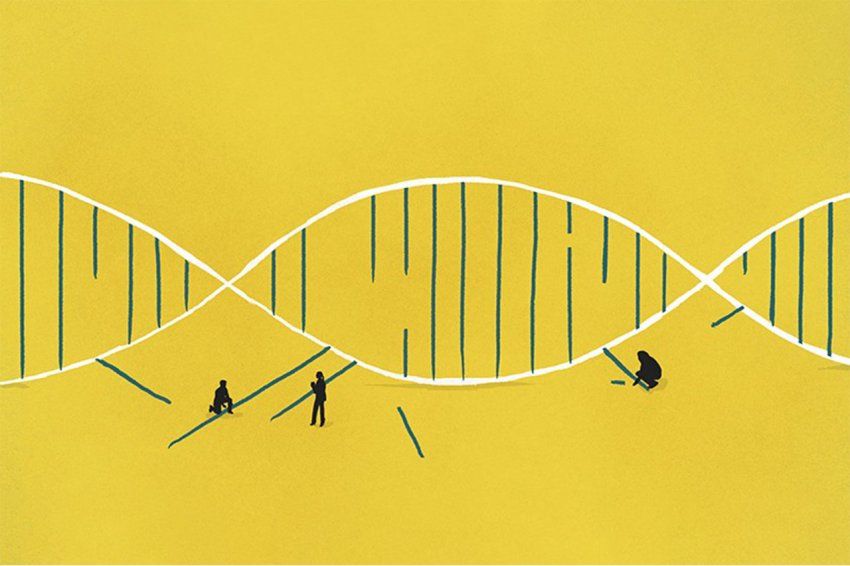New CRISPR Technology Offers Unrivaled Control of Epigenetic Inheritance

Scientists have figured out how to modify CRISPR’s basic architecture to extend its reach beyond the genome and into what’s known as the epigenome – proteins and small molecules that latch onto DNA and control when and where genes are switched on or off.
In a paper published April 9, 2021, in the journal Cell, researchers at UC San Francisco and the Whitehead Institute describe a novel CRISPR-based tool called “CRISPRoff,” which allows scientists to switch off almost any gene in human cells without making a single edit to the genetic code. The researchers also show that once a gene is switched off, it remains inert in the cell’s descendants for hundreds of generations, unless it is switched back on with a complementary tool called CRISPRon, also described in the paper.
Because the epigenome plays a central role in many diseases, from viral infection to cancer, CRISPRoff technology may one day lead to powerful epigenetic therapies. And since this approach doesn’t involve any DNA edits, it’s likely to be safer than conventional CRISPR therapeutics, which have been known to cause unwanted and potentially harmful changes to the genome.
“Though genetic and cellular therapies are the future of medicine, there are potential safety concerns around permanently changing the genome, which is why we’re trying to come up with other ways to use CRISPR to treat disease,” said Luke Gilbert, PhD, a professor at the UCSF Helen Diller Family Comprehensive Cancer Center and co-senior author of the new paper.
From Genome to Epigenome Editor
Conventional CRISPR is equipped with two pieces of molecular hardware that make it an effective gene-editing tool. One component is a DNA-snipping enzyme, which gives CRISPR the ability to alter DNA sequences. The other is a homing device that can be programmed to zero in on any DNA sequence of interest, imparting precise control over where edits are made.
To build CRISPRoff, the researchers dispensed with conventional CRISPR’s DNA-snipping enzyme function while retaining the homing device, creating a stripped-down CRISPR capable of targeting any gene, but not editing it. Then they tethered an enzyme to this barebones CRISPR. But rather than splicing DNA, this enzyme acts on the epigenome.
The new tool targets a particular epigenetic feature known as DNA methylation, which is one of many molecular parts of the epigenome. When DNA is methylated, a small chemical tag known as a methyl group is affixed to DNA, which silences nearby genes. Although DNA methylation occurs naturally in all mammalian cells, CRISPRoff offers scientists unprecedented control over this process. Another tool described in the paper, called CRISPRon, removes methylation marks deposited by CRISPRoff, making the process fully reversible.
“Now we have a simple tool that can silence the vast majority of genes,” said Jonathan Weissman, PhD, Whitehead Institute member, co-senior author of the new paper and a former UCSF faculty member. “We can do this for multiple genes at the same time without any DNA damage, and in a way that can be reversed. It's a great tool for controlling gene expression.”
‘Major Surprise’ Upends A Basic Tenet
Based on previous work by a group in Italy, the researchers were confident that CRISPRoff would be able to silence specific genes, but they suspected that some 30 percent of human genes would be unresponsive to the new tool.
DNA consists of four genetic letters – A, C, G, T – but, in general, only Cs next to Gs can be methylated. To complicate matters, scientists have long believed that methylation could only silence genes at sites in the genome where CG sequences are highly concentrated, regions known as “CpG islands.”
Since nearly a third of human genes lack CpG islands, the researchers assumed methylation wouldn’t switch these genes off. But their CRISPRoff experiments upended this epigenetic dogma.
“What was thought before this work was that the 30 percent of genes that do not have CpG islands were not controlled by DNA methylation,” said Gilbert. “But our work clearly shows that you don’t require a CpG island to turn genes off by methylation. That, to me, was a major surprise.”
Enhancing CRISPRoff’s Therapeutic Potential
Easy-to-use epigenetic editors like CRISPRoff have tremendous therapeutic potential, in large part because, like the genome, the epigenome can be inherited.
When CRISPRoff silences a gene, not only does the gene remain off in the treated cell, it also stays off in the descendants of the cell as it divides, for as many as 450 generations.
To the researchers’ surprise, this held true even in maturing stem cells. Though the transition from stem cell to differentiated adult cell involves a significant rewiring of the epigenome, the methylation marks deposited by CRISPRoff were faithfully inherited in a significant fraction of cells that made this transition.
These findings suggest that CRISPRoff would only need to be administered once to have lasting therapeutic effects, making it a promising approach for treating rare genetic disorders – including Marfan syndrome, which affects connective tissue, Job’s syndrome, an immune system disorder, and certain forms of cancer – that are caused by the activity of a single damaged copy of a gene.
The researchers noted that although CRISPRoff is exceptionally promising, further work is needed to realize its full therapeutic potential. Time will tell if CRISPRoff and similar technologies are indeed “the future of medicine.”
The University of California, San Francisco (UCSF) is exclusively focused on the health sciences and is dedicated to promoting health worldwide through advanced biomedical research, graduate-level education in the life sciences and health professions, and excellence in patient care. UCSF Health, which serves as UCSF’s primary academic medical center, includes top-ranked specialty hospitals and other clinical programs, and has affiliations throughout the Bay Area.